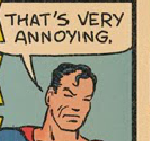|
As an American, Cricket vaguely scares and confuses me. Mostly the concept of Test Cricket. How can anyone play a game that lasts that long and not get dreadfully tired of it? Please explain, anyone who is in the know. It's lost upon me.
|
|
|
|

|
| # ? Apr 27, 2024 18:05 |
|
It's a chance to hang around outside on a nice summer's day and get smashed. Really though, test cricket is five days long because a-way-back-when, the English aristocracy wanted a game that the poors couldn't play, so they decided it should take an entire week. The poors couldn't afford the lost wages, so the bluebloods kept their game, even though they were a bit poo poo at it.
|
|
|
|
You have two sides, one out in the field and one in. Each man that's in the side that's in goes out, and when he's out he comes in and the next man goes in until he's out. When they are all out, the side that's out comes in and the side that's been in goes out and tries to get those coming in, out. Sometimes you get men still in and not out. When a man goes out to go in, the men who are out try to get him out, and when he is out he goes in and the next man in goes out and goes in. There are two men called umpires who stay all out all the time and they decide when the men who are in are out. When both sides have been in and all the men have out, and both sides have been out twice after all the men have been in, including those who are not out, that is the end of the game!
|
|
|
|
fins posted:You have two sides, one out in the field and one in. I don't know if this is genius or madness.
|
|
|
|
Hello I am an American cricket fan. I learned the basics from a HS teacher from Trinidad, and learned more when I did study abroad in India. They're rather fond of it there. Are you looking for a rules explanation or to hear why people like it?
|
|
|
|
Kind of a combination of both, making sense out of what the rules are, and also to hear why people like it.
|
|
|
|
Antifreeze Head posted:Really though, test cricket is five days long because a-way-back-when, the English aristocracy wanted a game that the poors couldn't play, so they decided it should take an entire week. The poors couldn't afford the lost wages, so the bluebloods kept their game, even though they were a bit poo poo at it. On the other hand there's now Twenty20 Cricket with it's Flashing LED Wickets and rock music.
|
|
|
|
Learn the often varied faces of M. Johnson. Such as this:  After he scared a batsman half to death with a 42m/s red rock.
|
|
|
|
Rudager posted:On the other hand there's now Twenty20 Cricket with it's Flashing LED Wickets and rock music. Also cheerleaders, who are often American imports. At least in the IPL. EDIT: 
Antifreeze Head fucked around with this message at 05:47 on Nov 25, 2014 |
|
|
|
The basic rules are fairly easy to pick up. The batting team has two players on the field at any one time. One is the active batsman, the other stands opposite him. The other team has one person bowling and the rest fielding. The bowler bowls the ball trying to hit the wicket behind the batsman. If he does, the batsman is out. If ten of the eleven members of the batting team go out, their innings is over. If the batsman manages to hit the ball, and it's caught before hitting the ground, he's out. If no one catches the ball and it goes over the fence, that's six points (runs). If it reaches the fence but doesn't go over, that's four points. Otherwise the batsman and his teammate run back and forth between each other's position. Each time they do so that's one point. While they're out of position the fielders can attempt to throw the ball back and hit the wicket. If they manage this, whichever of the batting team's wicket it was is out. The batting team can choose to stop running at any time and are safe as long as they're in position. When the running is done and the bowler has the ball back, they go again. In the course of the running the batsman and the other player on his team may have switched positions. This makes the second player the active batsman. There are a lot of silly names for fielding positions (eg. square leg, deep backward) and game events (eg. a duck is when a batsman goes out without scoring any runs, a maiden over is where a bowler bowls six times without the batsman scoring any runs) and there are additional complications (eg. if the bowler would have hit the wicket but the batsman's leg was in the way, the batsman is still out), but you can pick up most of it just by watching a match.
|
|
|
|
The Smithsonian has a good write up about cricket: http://www.smithsonianmag.com/people-places/cricket-for-dummies-132325801/?no-ist ESPN Cricinfo is probably the best site for cricket news and information: http://www.espncricinfo.com/ And of course the SA Cricket thread: http://forums.somethingawful.com/showthread.php?threadid=3525732
|
|
|
|
fins posted:You have two sides, one out in the field and one in. This ... this is amazing. 
|
|
|
|
Sperglord Firecock posted:Mostly the concept of Test Cricket. How can anyone play a game that lasts that long and not get dreadfully tired of it?
|
|
|
|
Tiggum posted:If no one catches the ball and it goes over the fence, that's six points (runs). If it reaches the fence but doesn't go over, that's four points. Otherwise the batsman and his teammate run back and forth between each other's position. Slight correction, there's a rope about a meter in from the fence that define the boundary. It's a 4 when it bounces before going over, or touches, the boundary rope, a 6 is when it goes over the boundary rope without bouncing.
|
|
|
|
If you can understand Baseball you can understand Cricket.
|
|
|
|
Here, OP https://www.youtube.com/watch?v=Oc_CesMUb5E
|
|
|
Sperglord Firecock posted:As an American, Cricket vaguely scares and confuses me. Mostly the concept of Test Cricket. How can anyone play a game that lasts that long and not get dreadfully tired of it? Cricket is weird and idiosyncratic and has no place in the modern world with its fast cars, fast women and demand for more, more, now, now But that's the beauty of it. Over the course of five days, you can see grown men brought to their knees as they enter into a psychological and physical Test of endurance. As a spectator, you can have the radio or TV on in the background, and slowly soak up the tension and drama as the match heads towards its conclusion. But all it takes is a batting collapse and suddenly a losing side is bearing back down on their opponents with renewed gusto. Even on the last day, anything is possible. Tail-end batsmen (bowlers) making 100 runs. Commentators cars being wrecked by six-hits that exit the stadium. The tips of men's penises smashed in against their protective boxes by the force of a 95mph in-swinger. The art of leg-spin. Or you can be more active, and take to watching a day or two at the ground, whilst doing the crossword and getting absolutely shitfaced on gin over the course of 7 hours It also comes in three convenient format: 20/20 - 240 max. balls are bowled, whoever hit these balls the best wins (takes maybe 2-3 hours) One-day - 600 max. balls are bowled, whoever hits these balls the best wins (takes about 7 hours) Test - An epic 5-day battle of wits and steel and moustaches, with varying victory conditions too lengthy and nuanced to bother mentioning o.m. 94 fucked around with this message at 20:15 on Nov 26, 2014 |
|
|
|
|
Also this https://www.youtube.com/watch?v=YtxnfqDJUWg
|
|
|
|
|
Just to remind everyone that even though it may seem like a slow and lazy 5 day game, it's still serious loving business in term of injuries, like any other sport. Phillip Hughes was knocked out cold two days ago from a bouncer that struck him in the head, today he was pronounced dead at age 25  . .
|
|
|
|
Paul.Power posted:"long periods of boredom punctuated by short moments of excitement" Sounds pretty much like watching baseball.
|
|
|
|
MightyJoe36 posted:Sounds pretty much like watching baseball. For instance, in cricket a batsman can leave as many balls as they like (providing it wouldn't get them out bowled, LBW or stumped), and they aren't compelled to run if they do hit the ball (of course, they often need to hit the ball defensively simply to avoid being bowled, etc.). These two things go most of the way to explaining why Test cricket can cheerfully go on for five days and still end in a draw sometimes (limited overs cricket creates an additional incentive for attacking batting through the pressure of setting up or chasing a total off a limited number of balls).
|
|
|
|
Has the best commentators, especially when you can hear them laughing in the background https://www.youtube.com/watch?v=yFPxSn69pcc https://www.youtube.com/watch?v=ia9b-HNGEIw even better when they talk to the crowd! https://www.youtube.com/watch?v=rKvzkn5GQkM https://www.youtube.com/watch?v=oKHieHIDg00 Ewan fucked around with this message at 01:14 on Dec 23, 2014 |
|
|
|
Cricket also has Soul limbo. https://www.youtube.com/watch?v=67xXbTaQlKI Where a slightly podgy man is a master of the game https://www.youtube.com/watch?v=gNggUD_MrNY The scorebooks are fascinating to look at too. I can't think of many games where they hold such detail.
|
|
|
|
Could someone who understands both cricket and American baseball explain some of the tactics that are still hard to grasp for us stupid Yanks, please? This is what I understand: A bowler hitting the wicket = strike out Leg before wicket - not Hit by Pitch, but more like interference (out) Caught fly ball = same in both, you (the batter) are out 6 runs = home run 4 runs = ground rule double Only 2 bases, home plate (current batter here), and the other home plate (other player here), which can switch for ?reasons? I get that the fielding positions have a lot of odd naming conventions, depending on where they (the defensive player) are in the field in relationship to the position/facing of the current batter. I understand that in cricket some players are primarily bowlers, while others are primarily batsmen, but it seems like everyone has to do both. In baseball this is not the case. Pitchers often have to bat, but they completely suck at it, and if a batter pitches, it is due to extreme circumstances, and often the height of hilarity (batters stink at pitching 10 times worse than pitchers stink at batting). Is there a "bowling rotation" (in that particular game) like in baseball there is a "pitching rotation?" (in that week) Does everyone bat? Does everyone pitch? Is it a requirement for everyone to bat and/or pitch? Do managers try to set up bowling/batting match ups for certain advantages vs. the other team? (My best guy vs. your best guy, OR my best guy [very good bowler] vs. your not-so-best guy [terrible batsman] ie; easy out)
|
|
|
|
I won't profess to know everything about baseball, but I can certainly try to answer the questions. Nerdfest X posted:
If the ball hits the wickets (and, more importantly, takes the bails off, which are the bits on top of the wicket), then you're out. Leg before wicket = the ball would have hit the wickets and taken the bail off (the umpire thinks), so you're out. Caught on the full = out. I think it gets a bit different with the home runs vs. 6 or 4 runs. My understanding of baseball is, you run to all of the bases, and then you (as an individual) have finished when you get to home. With cricket, if you get a 4 or a 6, it's impressive, and you return to where you were to face the next ball, but you haven't finished batting, and you stay there until either your team is out, you're out, you're injured, or your team declares (basically, decides that they have enough runs, and that they can get the other team out before they make the same number of runs or more). There are two ends of the pitch, and runs are scored by the batters running from end to end. If you hit the ball, you do not have to run. At both ends of the pitch is a line (called a crease), and if the ball takes the bails off the wicket before you get your bat on the other side of the crease (the side closest to the wickets), you're out. Nerdfest X posted:
Generally speaking, all players will have a bat (unless their team declares), but not all players have to bowl. It's not a requirement, written or unwritten, for everyone to have to bat and/or bowl. Your team can put forward whoever they want to bowl, more or less whenever they want them to bowl. However, there are usually some restrictions placed on how many overs (6 balls in a row bowled from one end) your bowlers can bowl each. There's no pitching rotation, and the captain can choose to bowl any bowlers at almost any time. The captain is ultimately in charge of what happens on the field (although they'll have worked out tactics with coaches etc. before), and tactics definitely come into it. I think generally decisions of who to use to bowl are made on a case-by-case basis (for example, two bowlers might work well together bowling in turns, or one batter might be awful at batting against spin bowlers). Whitlam fucked around with this message at 07:32 on Dec 27, 2014 |
|
|
|
One of the real joys about cricket is that it's one of the few sporting games in the world where the conditions vary wildly not only from match to match, but usually several times within each match. The pitch breaks down over the course of five days and batting becomes more difficult. The ball itself moves differently through the air depending on how long the game has progressed, how much cloud cover there has been throughout the day, etc. It's probably the sporting contest where winning the coin toss is most beneficial. It's a game played 50% in the head which is fascinating to watch. Players will actively verbalise one another to try to throw the other off their game. Bowlers try to tread a fine line between outright frightening the batsmen by trying to bounce the ball into their heads, and trying to bowl disciplined balls that are impossible to attack. Similarly batsmen tread a fine line between trying to keep the runs flowing, while not attacking balls that are too dangerous - and making the distinction between the two in the space of one second as a ball flies at them at up to 100mph. The difference between a good batting innings and a bad one is often a single lapse in concentration, either from the batsman making an error, or one of the fielding sides dropping a vital catch. Sometimes teams have to decide whether they're a realistic chance of winning, or whether to play defensive in the hopes of a draw - since the five day test matches are usually just one in a series of matches, preventing the loss can mean the difference between winning or losing an entire series which might last the best part of two months. It's also a goon's dream in that there are a billion stats and since the game moves at a slow walking pace for five days there is all the time in the world for everyone to dig them up and follow them. It's very common during a match for a commentator to describe how such and such batsmen is approaching the record for the highest ever run score in the second innings for a #6 batsman on this ground against that team. There is some kind of record broken, or at least approached, more often than not. It's also just a fantastic sport to follow when you're actually busy since you can just check the scores every five minutes and you won't have missed much. Very few people will actually sit down and watch the match intently for five days straight, and those who do go to the ground for all five days usually spend most of the time getting drunk as gently caress and baking in the sun. If you want to get into the sport, it might be easier to watch some of the shorter forms of the game to begin with. There is a form of cricket called 20/20 where each side has 20 overs (120 balls each) to try to score as much as they can. Since there are only 120 balls and they still have 10 wickets, sides aren't as concerned about getting out so they just try to smash the ball out of the park as often as possible, and the whole thing is over in a few hours. It's really just a popcorn game and not nearly as intriguing or tactical as test cricket but it is a good way to gain an understanding of the rules of the game and how it's played, and its generally pretty action-packed. India has an entire league dedicated to 20/20 games (the Indian Premier League) and Australia has a 20/20 competition called the Big Bash League if you want to look any of them up. cmndstab fucked around with this message at 09:01 on Dec 27, 2014 |
|
|
|
cmndstab posted:The ball itself moves differently through the air depending on how long the game has progressed, how much cloud cover there has been throughout the day, etc. It's probably the sporting contest where winning the coin toss is most beneficial. Also the fielding team does what basically amounts to legal tampering with the ball by polishing up one side of it so when pace bowlers come out the ball swings without the bowler having to do much to cause the swing because of some physics poo poo.
|
|
|
|
Rudager posted:Also the fielding team does what basically amounts to legal tampering with the ball by polishing up one side of it so when pace bowlers come out the ball swings without the bowler having to do much to cause the swing because of some physics poo poo. They also periodically exchange the ball for a new one (since it gets busted up over time) but the captain has to decide when he wants to do this because although the new ball is better for the fast bowlers, the old busted up ball is actually better for the spin bowlers. Again, quite tactical and it would all depend on who is batting, which bowlers are available, etc.
|
|
|
|
As an Australian it took me years to actually find the game enjoyable. A lot of the enjoyment of test cricket (the multi day games the OP speaks of) is in the tactics. But what makes the experience sweet is individual moments of brilliance, like Shane Warne's "bowl of the century". I think that even non sport-fans can agree that to put so much spin on a ball is quite incredible. https://www.youtube.com/watch?v=XNRsfhGtnB4
|
|
|
|
Nerdfest X posted:Could someone who understands both cricket and American baseball explain some of the tactics that are still hard to grasp for us stupid Yanks, please? Could someone who understands both cricket and American baseball explain some of the tactics that are still hard to grasp for us stupid Yanks, please? This is what I understand: A bowler hitting the wicket = strike out Leg before wicket - not Hit by Pitch, but more like interference (out) Yes, but only if the umpire believes that the ball would've hit the wicket. There are some more subtle rules as well about where it bounced and where it hit, but I won't go in to those Caught fly ball = same in both, you (the batter) are out 6 runs = home run Not quite - you get 6 "points". You can also score 1, 2, 3, 4 and 5 rarely. But the mechanism through which it happens (ball over boundary without bouncing) is the same. 4 runs = ground rule double Kind of. All it has to do is "touch" or roll past/bounce over the boundary (usually a rope on the floor). It can roll at 1mph, still be on the pitch, but if it touches that rope it's 4. Only 2 bases ("wickets"), home plate (batsman "on strike" here), and the other home plate (other batsman here), which can switch for ?reasons? Putting aside "fours" and "sixes", the fundamental way to score is by the two batsmen (both are "current") running between the two wickets (the pitch has identical wickets at both ends) after hitting the ball. Each time they switch ends, they get 1 run. They have to judge how many times they can switch places ("run") before the fielding team gets the ball back to the wickets - if they are mid-way through switching places ("running") when the fielding team gets the ball back and strikes the wicket, the one running towards that wicket is out (not necessarily the same guy who hit it). This is called "run out". A "four" or a "six" negates the need to physically run. If they get an even number of runs (incl 0), the same batsman will be on strike for the next ball. If they get an odd number, his partner will be on strike. There is another way the batsmen "switch" strike: Every six balls (called an "over"), the fielding team switches bowler and they bowl from the other end - the batsmen stay where they were, which means the second batsman will be on strike (unless the last hit was an odd score). I get that the fielding positions have a lot of odd naming conventions, depending on where they (the defensive player) are in the field in relationship to the position/facing of the current batter. Yes, yes they do. Silly mid-off, long-on, deep fine leg, third man, slips, gullies... all of these are very common positions I understand that in cricket some players are primarily bowlers, while others are primarily batsmen, but it seems like everyone has to do both. In baseball this is not the case. Pitchers often have to bat, but they completely suck at it, and if a batter pitches, it is due to extreme circumstances, and often the height of hilarity (batters stink at pitching 10 times worse than pitchers stink at batting). Incorrect. You have bowlers, you have batsmen, and you have all-rounders (who are good at both). A team is 11. Everyone has to bat (unless you win before you get there), but a lot of the bowlers are hilariously bad and will be the last up. Only a few players will bowl (4-6 generally) - in simple terms, you'll have a few "fast" bowlers, and a few "spin" bowlers. Some might be good batsmen too (Andrew "Freddie" Flintoff, for example), but there will be many batsmen you will never see bowl. Depending on the type of game (test, one day), there will often be limits on how many "overs" a bowler can bowl Is there a "bowling rotation" (in that particular game) like in baseball there is a "pitching rotation?" (in that week) Does everyone bat? Does everyone pitch? Is it a requirement for everyone to bat and/or pitch? see above Do managers try to set up bowling/batting match ups for certain advantages vs. the other team? (My best guy vs. your best guy, OR my best guy [very good bowler] vs. your not-so-best guy [terrible batsman] ie; easy out) Yes, but it's a bit more complex. In a test match, you'll normally start with your fast bowlers. This is because they are often harder to score runs against, and takes advantage of the nice new shiny ball. You are more concerned about keeping their score down than getting them out quickly. Depending on how soft/messed up the pitch is, you'll often bring in in your spin bowlers a bit later - they prefer a scratched up ball. But, some spin bowlers give away a lot of runs so it can be risky. You often switch it up to give the bowlers a rest (fast bowlers get knackered), and to keep the batsman on his toes. You'll often find, at the end, a fast bowler brought in to bowl against the shittest players as they often can't cope with 80mph+. All of this is very very subjective though, and depends upon the pitch, the quality of bowler (you might have a super good spin bowler, but only average fast bowlers (like Australia in 90s), the type of batsman, and the type of match (test, one day, etc). The other thing you can do is adjust your field. You can have an "agressive" field, where you have lots of slips (the guys just behind and to the side of the batsman) and close fielders - these can then catch any mishits - but it means a good batsman can easily hit "fours" because no one guards the boundary. Or - you can have a very "defensive" field, where you have your fielders far out to stop "fours", meaning they can only easily score 1s and 2s. In a test match, you'll see a lot more defensive fielding, whereas in a short match (one day or Twenty20 - more on that below) you'll get more aggressive fielding (and more agressive batting). Right, and now some extra info to confuse you! There are 11 (!) ways for a batsman to get out. The first five are the main ones, you rarely see the others. Bowled (bowler hits wicket) LBW (leg before wicket - bowled ball hits batsman's leg. Ball must've been on way to hit wicket. If it bounces outside line of leg stump - not out. If it hits outside of off-stump and batsman playing a shot: not out. If it hits bat before leg: not out. Ball doesn't have to bounce. Fielding team must "appeal" to the umpire if they think it's out "HOOWWWZZAATTTT?!?!?") Run out (fielders get ball back to wicket while batsmen still "running") Caught (fielder catches hit ball before it bounces) Stumped (wicket keeper (backstop) hits the wickets with the ball/hand after batsman steps outside of his area -see image below) Hit wicket (batsman accidentally hits his own wicket with bat/body (or his helmet fall off onto it, which happened a few years ago! Rare) Hit ball twice (unless ball was going to hit the wicket, in which case you are allowed to - very rare) Timed out (batsman took too long to get on the pitch to replace someone else - very rare) Retired (batsman walks off - very rare) Handled ball (batsman touches ball with his hand (not incl hand holding bat). requires fielding team to "appeal". Very rare) Obstructing the field (getting in the way of a fielder. very rare) Description of "stumped":  You can see the dude has completely missed the ball, and is way outside of his area ("crease" - the white line). Assuming the ball misses the stumps directly, all the wicket keeper has to do, is catch the ball and while holding it knock the stumps. This will be out by being "stumped". Finally, a description of the types of matches: First Class (colloquially called "test" cricket, but that is only a subset of this) This is over 3 or more days (5 for "test", 4 for county cricket). Each team has two innings. To win, you must have scored more runs and have got the whole of the opposing team out twice. If neither team is completely out twice, then it is a draw. All players wear all white. Ball is dark red. Each day is typically 80-90 overs (sets of six balls bowled). A batting team can "declare" if they choose, which means they finish their innings. They might do this if they have scored a lot of runs, but are worried they might run out of time to get the whole of the other team out. An example score might be: Day 1 - England score 200 runs, 7 out. End of day, Engand still in score 200-7 Day 2 - England score another 40 runs, 3 out at 11am (England end of 1st innings, 240). Australia score 300 runs, 3 out. End of day, Australia still in, score 300-3. Day 3 - Australia score another 100, but 7 out, by 3pm. Australia end of 1st innings, 400. England come in, score 170, 3 out, then end of day. Day 4 - England score another 330 runs, only 4 more (=7) out, but "declare" at 4pm to give themselves time to bowl Australia out. Australia come in, score 30, none out, end of day. Now, we're on Day 5. The score is: England 740, and have had both innings. Australia 430, but have one whole innings to go. So if: England get all of the Australians out before they reach 310 (and before day 5 ends (normally 6pm)) = England win (if Aus were "all out" for 300, then "England wins by 10 runs") Australia get 311+ before day 5 ends = Australia wins (if they scored 311 with 6 out, then "Australia wins by 5 wickets"). Australia don't get 341+, but at end of day 5 still have players left in = draw (even if the final score is like ENG 740 - 600 AUS, if Aus have players left they draw). England get all of the Australians out, and they get 340 exactly = a "tie" (very rare) One day Each team gets 1 innings each of 50 (international) or 40 (some county) overs. Remember an over is a "set of six balls". This is more fast paced, and there is no "draw" - all you need to do to win is get more runs than the other team - you don't have to get them all out. "Ties" are possible, and more common than test, but still rare. Players tend to wear coloured kits, and the ball is often white. There are often limits over where you can put fielders (to avoid having a too-defensive field). A 50 over game lasts 5ish hours. If a team gets less than 50 to bat (say because of rain), there is a complex formula to predict the amount of runs they would have achieved. Twenty20 Makes the elitists cringe. Relatively new invention. Pretty much same rules as one day, but rather than 50/40 overs each, you get 20 overs each. This is to make it more of a crowd pleaser - the format encourages big hits and more risky play, making it more exciting. A game lasts about 2 hours. You get cheerleaders. The same players play the different formats, but some might be better at others (e.g. a defensive batsman will be great for test, but not so good for Twenty20). How it works in competition "Test" cricket This refers to the 5 day matches played between teams from the test nations (UK, Aus, S.Africa, NZ, India, Pakistan, Bangladesh, West Indies, Sri Lanka, Zimbabwe). There is no international format competition (i.e. no "world cup") - instead one team will play another in a series of 5/7 games, the overall winner being the one who wins more games. These are scheduled in a way to ensure all countries play each other over a period of a few years, so that there can be an official ranking table. (S. Africa is currently top). Test series will often be combined with a few One Day International matches too, and maybe a couple of Twenty20s for good measure. One regular and famous series is The Ashes - this is an England vs Australia series of 5 matches that is held at least once every four years (venue alternates between England and Aus). International competitions There are a few international competitions, all either One Day or Twenty20. This includes the Cricket World Cup (one day matches - once every four years, includes the 10 "test nations" plus qualifying teams.) The ICC World Twenty20 is the Twenty20 equivalent, and is every 2 years. Domestic competitions In the UK, domestic cricket is played by counties. The four-day format competition is a league of 18 counties. There is also a one-day Cup (which includes Scotland and for some reason the Netherlands), and a Twenty20 cup.
|
|
|
|
On the subject of "declares" - Please tell me this decision has historically backfired at one point, and the other team made them pay. When would you declare due to time? Is there a clock? Is it real time, where the clock keeps running regardless of play on the field (your football, what we call soccer) or is it closely monitored to only elapse time while there is something actually happening during the game (basketball/hockey)? Are there defensive specialists? Like a player whose batting is sub-par, can't bowl worth a lick, but can play silly point better than anyone else in the league. Do defensive players play the same general area match to match? Do bowlers who are no good at batting just go up there with the intention of not even trying because they are awful at it? The batsmen line-up: Is it usually best-to-worst as far as batting order? I'm sure certain situations arise where this can change (Player A, our best batter, for some reason has bad luck vs. Player X, the other team's 1st bowler, so lets move him down in the line-up). How many runs are expected from a typical at-bat from the 1st few batsmen? Can one batsmen theoretically stay at bat indefinitely (time permitting)? Are there batsmen who routinely hit for sixes and/or fours and do so multiple times in a row? Would the 2 current batsmen forgo a run, to keep it even, in order to keep the same batsman facing the same bowler? Like they could have switched places, but choose not to, because "I own this guy, but you have problems vs. him. Let's let me keep batting against him" Have they instituted video replay to help make on-field decisions?
|
|
|
|
Nerdfest X posted:On the subject of "declares"....... Yes, it is a gamble. It's a balance between having enough runs in the lead that they won't catch up, but giving yourself enough time left in the game to get them all out. Sometimes you might declare, and then the other team steams ahead and wins. When would you declare due to time? Is there a clock? Is it real time, where the clock keeps running regardless of play on the field (your football, what we call soccer) or is it closely monitored to only elapse time while there is something actually happening during the game (basketball/hockey)? There is no "clock" per se. For a 4/5 day game, it will typically run from about 11am til 6pm, with a couple of breaks (lunch and tea). For one day or Twenty20, it is done on numbers of overs (sets of six balls). If the game is delayed, then the umpire can reduce the number of overs. So if it's a 50 over game, and the start is delayed by 2 hours due to rain, the umpire might say "Ok, both teams will only play 30 overs". Or, if the first team plays 50, but then rain causes the second team to only get 30, that is where a special (complicated) formula is applied to the second team's score to "predict" what they would have got if they'd played the full 50. The formula/rule is known as "Duckworth-Lewis" (no, this is not a joke). Are there defensive specialists? Like a player whose batting is sub-par, can't bowl worth a lick, but can play silly point better than anyone else in the league. Do defensive players play the same general area match to match? Simply put, you will generally get picked based upon one of 4 reasons: 1. you are a very good batsman (appreciating there are different styles) 2. you are a very good bowler (again appreciating different types - you wouldn't pick 5 spin bowlers and no fast) 3. you are good/very good at both (an all-rounder) 4. you are a good wicket keeper that can also bat OK. (wicket keeper is a specialist position). Within this, you might be placed in the field depending on what you are good at (there will be players who are very good slips, a fielding position that requires good reflexes and agility, for example). But being a good fielder (e.g. "good at silly point") is a highly unlikely reason to be picked. Do bowlers who are no good at batting just go up there with the intention of not even trying because they are awful at it? They will normally go up to bat with one of two mindsets (these are my own terms): 1 - SLOG. For this, they will try and smash the ball as hard as they can - this means they might get a few fours or sixes before they get out. They won't last long, but will hopefully get a decent number of runs. Of course this risks them getting out v quickly having scored nothing. 2 - DIG IN. Often if it's very close to the end of the match (or end of the day) and your team is on the brink of losing, you may want to simlpy stay in to try and force a draw. This means they won't try and get any runs, just simpy avoid getting out by playing the safest shots possible. However, you need to be a skilled batsman to do this well, so this is difficult. Some teams might employ a "night watchman" - this is someone who is good at digging in but "sacrificable" (normally a bowler who is OK at batting). They would be put in towards the end of the day when the light is failing - this means you don't risk losing your good batsmen in the dark light, where it's easier to get out because you can't see the ball so well. The batsmen line-up: Is it usually best-to-worst as far as batting order? I'm sure certain situations arise where this can change (Player A, our best batter, for some reason has bad luck vs. Player X, the other team's 1st bowler, so lets move him down in the line-up). Pretty much, but your best two are normally at 3 & 4. 10/11 will always be the worst. The order is decided beforehand, but can be switched up if you want to put in a night watchman or whatever. It would be very rare to adjust batting order for a bowler - the fielding team can change bowlers at will so they'd just change them. How many runs are expected from a typical at-bat from the 1st few batsmen? Can one batsmen theoretically stay at bat indefinitely (time permitting)? Are there batsmen who routinely hit for sixes and/or fours and do so multiple times in a row? It varies across different formats of cricket. But in general, a half century (50) and a century (100) are considered to be good milestones. It's rare but not impossible to get 200+. The record is 400. There are batsmen who are known to be "sloggers" - those that will tend to get more sixes/fours than others (say, Kevin Pietersen), whereas others are more classical defensive batsmen who stay in for a long time but score slowly (e.g. Paul Collingwood). You have a statistic known as a "strike rate" which is a measure of how fast you score runs (it's runs per 100 balls). A run rate of 100 means you are scoring 1 run for every ball you face - it is rare, and you'd only really see it in a Twenty20, or for the last couple of batsmen in a test match who might only face 3 bals, but hit a 6 (getting a s/r of 200). In test cricket, a strike rate of 40 is considered good (although as low as 20 would be fine for your first up on day 1, or if you're digging in for a draw). In one day, you're aiming more for ~70, and in Twenty20, even higher. Would the 2 current batsmen forgo a run, to keep it even, in order to keep the same batsman facing the same bowler? Like they could have switched places, but choose not to, because "I own this guy, but you have problems vs. him. Let's let me keep batting against him" Sometimes. It's more likely if you're in a situation where you have one very good batsman and one very poor (maybe number 3 is still in when they get to number 10), then they will likely try and keep the better one on strike as much as possible (within reason). Have they instituted video replay to help make on-field decisions? Yes. To varying degrees. Generally, the Umpire can call for a Third Umpire to help with a decision, who will then review TV replays. For some decisions they also use acoustic sensors (snickometer), infrared images (hotspot), and 3D ball-tracking simulation (HawkEye) to help with the decision. More recently, some competitions allow a "review" system where the teams have a set number of Reviews, where they can ask for a video replay if they disagree with the umpire. They might be allowed 2 Reviews - if they are proven correct then the number stays the same, whereas if the are incorrect they lose a Review (similar to how it works in tennis). Examples: Hotspot: http://www.youtube.com/watch?v=_CTfREipYxc In this situation, the umpire gives OUT for LBW. The Batsman disagrees and asks for it to be reviewed. The "hotspot" shows that the ball hit the bat before it hit his pad, and therefore is NOT LBW and the decision is reversed. Snickometer: https://www.youtube.com/watch?v=H96PPrwVxMs In this situation, "snickometer" shows that the bat did not hit the ball (the noise the umpire heard was the bat hitting the ground), so the umpire should not have given it out (he gave it out for caught). This was before the teams were allowed to ask for a review of decisions so he stayed out. Hawkeye: https://www.youtube.com/watch?v=hYQA4mmdxhE In thsi video, the team appeals for LBW but the umpire says no. HawkEye shows it actually should have been given. In this instance it was only used for the benefit of the TV audience, but it is used for Third Umpire / Review decisions too. And bonus "hotspot" video: https://www.youtube.com/watch?v=oKHieHIDg00 Ewan fucked around with this message at 16:49 on Dec 27, 2014 |
|
|
|
Lilbeefer posted:As an Australian it took me years to actually find the game enjoyable. A lot of the enjoyment of test cricket (the multi day games the OP speaks of) is in the tactics. But what makes the experience sweet is individual moments of brilliance, like Shane Warne's "bowl of the century". Speaking of Shane Warne, I can't think of a single other professional sport where a pudgy middle aged smoking man is a world class competitor, even in 1995 or whenever it was when he was in his prime.
|
|
|
|
Rudager posted:Speaking of Shane Warne, I can't think of a single other professional sport where a pudgy middle aged smoking man is a world class competitor, even in 1995 or whenever it was when he was in his prime. Check out equestrian sports, it's full of them. This is my favourite impression of cricket. https://www.youtube.com/watch?v=dEH4ahCCrJo
|
|
|
|
Rudager posted:Speaking of Shane Warne, I can't think of a single other professional sport where a pudgy middle aged smoking man is a world class competitor, even in 1995 or whenever it was when he was in his prime. Darts and snooker spring to mind.
|
|
|
Rudager posted:Speaking of Shane Warne, I can't think of a single other professional sport where a pudgy middle aged smoking man is a world class competitor, even in 1995 or whenever it was when he was in his prime. This is one of my favourite things about cricket. It's such a mental game and so multidisciplinary that anyone, any body type, can find some way to contribute and play to a high level. Chandrasekhar even had a hosed up unusable arm due to childhood Polio but was a great leg-spin bowler in the 60s/70s.
|
|
|
|
|
Ewan posted:An example score might be: Unless you're Australian, in which case it's 7-200. That's not a joke, by the way, we actually say the scores the other way around here. And if you're saying it rather than writing, it's "7 for 200" (or "200 for 7" in the rest of the world).
|
|
|
|
Sperglord Firecock posted:How can anyone play a game that lasts that long and not get dreadfully tired of it? A good test match will seesaw this way and that, as each side gains the ascendancy then loses it. It's sort of like why some people prefer epic multi-volume fantasy novels as opposed to disposable comic books, I suppose.
|
|
|
|
Nerdfest X posted:The batsmen line-up: Is it usually best-to-worst as far as batting order? I'm sure certain situations arise where this can change (Player A, our best batter, for some reason has bad luck vs. Player X, the other team's 1st bowler, so lets move him down in the line-up). Ewan's answer is right, but sometimes in a limited overs game you might fiddle with the batting order during the game based on how many overs are left. For instance, if you only have a couple of overs to go and have to send a new batsman in, you might choose to "promote" an aggressive batsman who will score runs quickly up in favour of a batsman who takes awhile to get going. In this case, with so little time left, it doesn't really matter that the aggressive batsman is a lot more likely to get himself out.
|
|
|
|

|
| # ? Apr 27, 2024 18:05 |
|
Ratios and Tendency posted:This is one of my favourite things about cricket. It's such a mental game and so multidisciplinary that anyone, any body type, can find some way to contribute and play to a high level. Chandrasekhar even had a hosed up unusable arm due to childhood Polio but was a great leg-spin bowler in the 60s/70s.  
|
|
|







 Tater Love
Tater Love 













 Cat Army
Cat Army 









